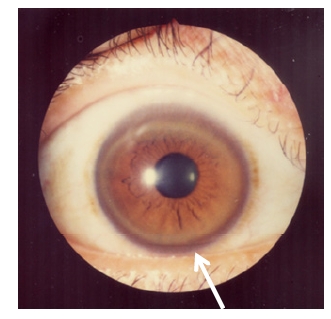Playlist
Show Playlist
Hide Playlist
Metabolic Liver Disease with Case
-
Slides Gastroenterology 12 Liver Pt2 NAFLD.pdf
-
Reference List Gastroenterology.pdf
-
Download Lecture Overview
00:00 Welcome. 00:01 Today we'll talk even further about disorders of the liver and biliary system specifically about metabolic liver disease, Wilson disease and hemochromatosis. 00:11 So let's start with a case. 00:13 A 68-year-old man is seen in clinic for follow-up of abnormal liver test. 00:18 He has a past medical history of type 2 diabetes, hypertension and obesity. 00:24 He takes metformin and lisinopril. 00:26 He has 1 to 2 glasses of wine daily but does not smoke or use illicit drugs. 00:32 Vitals are normal, his BMI is 40. 00:36 Physical exam is notable for hepatomegaly but no jaundice or spider angiomata. 00:42 There is no ascites or edema. 00:45 Labs are notable for an ALT of 80 (U/L), AST 59 (U/L) but albumin, INR, bilirubin, CBC and iron studies are all normal. 00:56 A liver ultrasound shows an enlarged fatty liver. 01:00 So what is the recommended treatment for his condition? Let's first go into some key details in this case. 01:07 He has multiple metabolic disorders with his hypertension, type 2 diabetes and obesity. 01:14 On exam, he has both obesity, hepatomegaly and no signs of cirrhosis. 01:20 His labs show a mild elevation in the AST and ALT. 01:26 And his imaging shows fatty liver. 01:29 So at this point, you may be considering some things in his history such as his alcohol use. 01:34 However, he has 1 to 2 glasses of wine daily, so this is not heavy alcohol use so he'd most likely does not have alcoholic liver disease. 01:43 You might also consider a condition such as hemochromatosis on your differential but his iron studies are normal, so this makes that diagnosis pretty unlikely. 01:53 So before we go on to the answer for this question, let's talk a bit about metabolic liver disease. 02:00 So metabolic liver disease is the most common cause of abnormal liver tests that you will find in western industrialized countries. 02:08 It has a spectrum of disease. When there is only fatty liver but no inflammation, this is called metabolic dysfunction-associated steatotic liver disease (MASLD). 02:19 This was previously known as nonalcoholic fatty liver disease (NAFLD). When inflammation is present, this is called metabolic dysfunction-associated steatohepatitis or MASH, previously known as nonalcoholic steatohepatitis (NASH). 02:35 So, unsurprisingly, many of the risk factors for MASLD or MASH, depend on metabolic syndromes. 02:43 So, any metabolic syndrome, hypertension, hypertriglyceridemia, insulin resistance or type 2 diabetes and obesity are all common risk factors for these diseases. 02:56 This disease is often found incidentally on liver tests just with mild elevation in the transaminases. 03:03 However, it can also progress to cirrhosis and eventually, hepatocellular carcinoma. 03:10 So, we go first from healthy hepatocytes to eventually, bloated hepatocytes with fatty liver infiltration, so this is MASLD. 03:21 And then eventually, you may develop inflammation and death of hepatocytes which is now MASH. 03:28 Both of these conditions are reversible if you treat and target the underlying factors. 03:34 However, once it has progressed to cirrhosis or scarring of the liver, you now have irreversible injury. 03:43 So the diagnosis used to be made with liver biopsy. 03:47 However, since that is such an invasive test, now we know that presumptive diagnosis can be made by looking at risk factors for MASLD and MASH, evidence of fatty liver or hepatic steatosis on imaging and having mildly elevated transaminases. 04:05 The treatment consist of controlling the underlying risk factors. 04:08 So in most cases, you can counsel patients on weight loss and this can also reverse their liver injury. 04:17 So now, we go back to our case. 04:19 A 68-year-old man who has multiple metabolic disorders, a mild elevation in his transaminases and fatty liver on imaging. 04:28 Notably, we now know he has no heavy alcohol use and his normal iron studies make hemochromatosis pretty unlikely. 04:36 So, his most likely condition is metabolic liver disease or MASLD or MASH. 04:42 The recommended treatment for his condition is recommending weight loss and control of his hypertension and diabetes.
About the Lecture
The lecture Metabolic Liver Disease with Case by Kelley Chuang, MD is from the course Disorders of the Hepatobiliary Tract.
Included Quiz Questions
Which of the following is a risk factor for metabolic liver disease?
- Type 2 diabetes mellitus
- Loss of appetite
- Type 1 diabetes mellitus
- Hypotension
- Hypotriglyceridemia
Which of the following is the recommended treatment for metabolic liver disease?
- Weight loss
- Liver transplant
- Phlebotomy
- Penicillamine
- Lactulose
Customer reviews
5,0 of 5 stars
| 5 Stars |
|
5 |
| 4 Stars |
|
0 |
| 3 Stars |
|
0 |
| 2 Stars |
|
0 |
| 1 Star |
|
0 |




